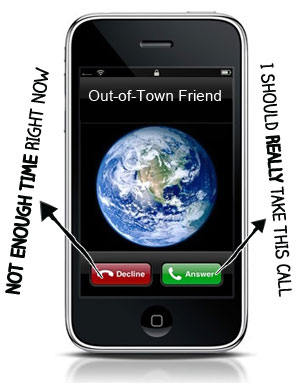I got a call from an out-of-town buddy a few weeks ago asking me for advice on which of two running backs he should start in his big fantasy football matchup that weekend (it was between Cedric Benson and Willis McGahee for you other NFL nerds out there). For some reason, that call – which was not at all an uncommon sort of call from this particular friend – got me thinking.
 You know how you have those out-of-town friends who you talk to about once every six or twelve months, and when you see their name pop up on your ringing cell phone you go, “Oh man, I can’t take this right now”? It’s not because you don’t want to talk with them – in fact they might be one of your best friends and you feel a little bit guilty for not answering. It’s because you know it’s gonna be an hour-long conversation to really catch up. And you don’t have an hour right now. Too much of a commitment, right?
You know how you have those out-of-town friends who you talk to about once every six or twelve months, and when you see their name pop up on your ringing cell phone you go, “Oh man, I can’t take this right now”? It’s not because you don’t want to talk with them – in fact they might be one of your best friends and you feel a little bit guilty for not answering. It’s because you know it’s gonna be an hour-long conversation to really catch up. And you don’t have an hour right now. Too much of a commitment, right?
Well, I have plenty of those friends too and I do the same thing. But when the guy I mentioned in the first paragraph calls, I always pick up. So I started thinking about why that’s the case. Here are the things that came to mind:
- The conversations are almost always quick (usually 5-10 minutes long)
- The topics of our conversations are about simple, timely things 90% of the time (football, something funny that happened, a quick question, etc.). In other words, we don’t begin by catching each other up for 20 minutes each on our lives because we already know what’s going on.
- He’s an entertaining guy, and the call consistently ends in us laughing about something absurd
What’s really interesting to me is that when I compare the cumulative, quick and manageable conversations that I’ve had with this friend over the past year or so, I’m certain the minutes spent talking far surpasses the minutes spend talking to any of my hour-long-conversation buddies. And the relationship is stronger. Furthermore, when he or I might have something of greater importance to talk about, we both know the other will be reachable.
So why am I writing about this on a marketing blog?
It’s because I believe the exact same parallels can be drawn to the way a successful business-to-business brand in today’s marketing environment captures the attention and builds a relationship with their customer.
I love a reading a great business book, navigating a well-thought-out and engaging website or reading a well-crafted white paper that educates me on a topic of interest. But putting these big, time-consuming works together is a massive project for those who developed that content. Comparison: hour-long-conversation. It’s a commitment and not something that can be done every day or week. More like every few months or years.
The strongest and most engaging business-to-business brands on the other hand, embrace the idea that not every piece of content they produce for their audience has to be a masterpiece. They realize they don’t have to wait until the perfect time to release it. That’s why these brands write multiple blog posts a week, create infographics, produce raw viral videos, put on half-hour long lunchtime webinars, etc., etc.
Great brands develop and maintain a strong relationship with their audience through frequent and simple engagements. Though they might hang their hat on their bigger productions, they complement those with smaller pieces that keep their audience interested all the time. Compare the following to the bullet points listed previously in this post:
- Their content is short and sweet (again – blog posts, infographics, etc.)
- The topics of their content are timely and focused so they can be delivered quickly (not broad and all-encompasing)
- Their content is engaging and/or entertaining and relates to their customer at a human level.
See the parallels? I think they exist because customers are real people. Business-to-business brands that actually think about how real people interact in their daily lives have much a better chance of capturing the interest of their customers and building a long-lasting relationship.
I’d love to hear your comments on this one below. Please feel free to contribute.